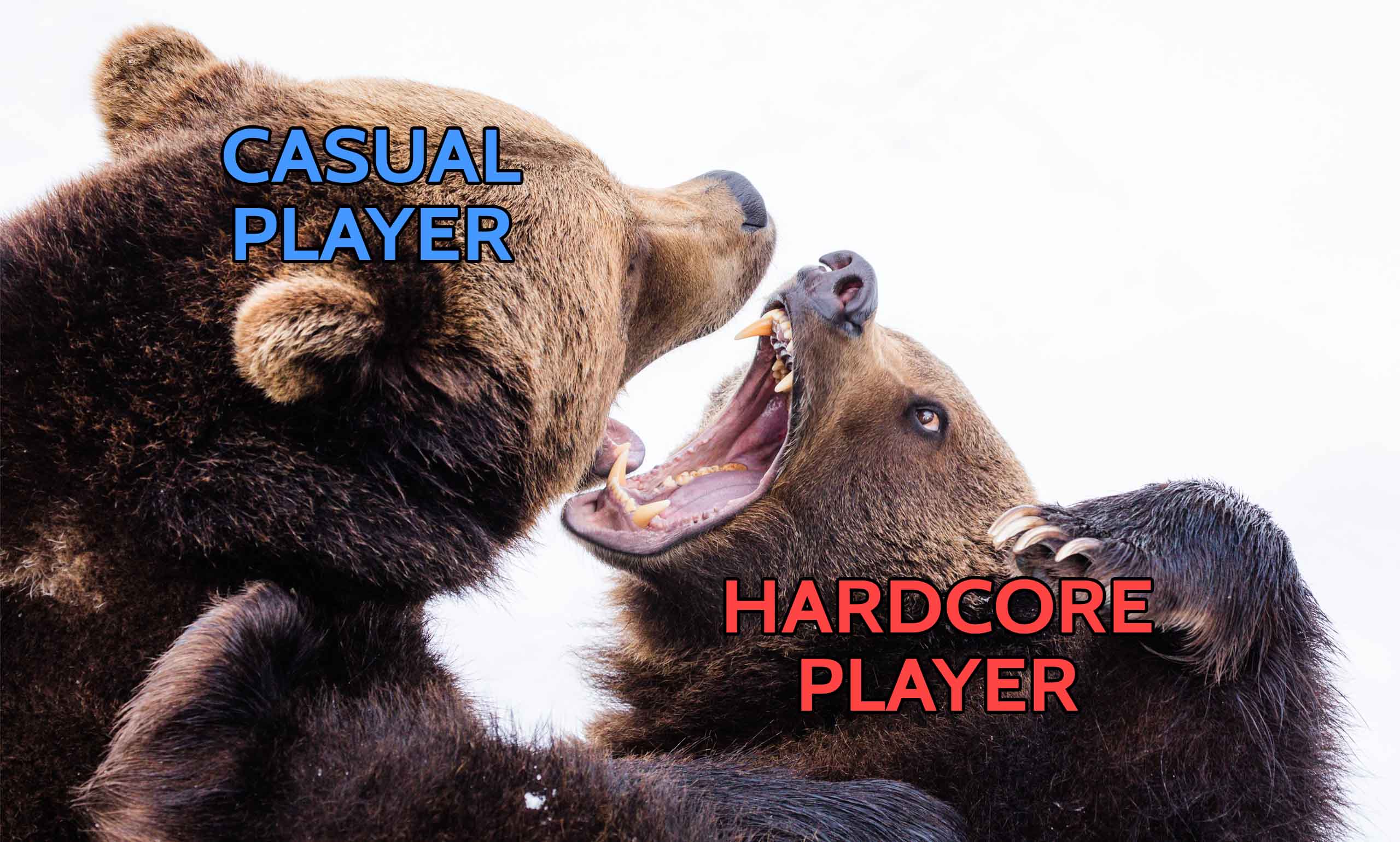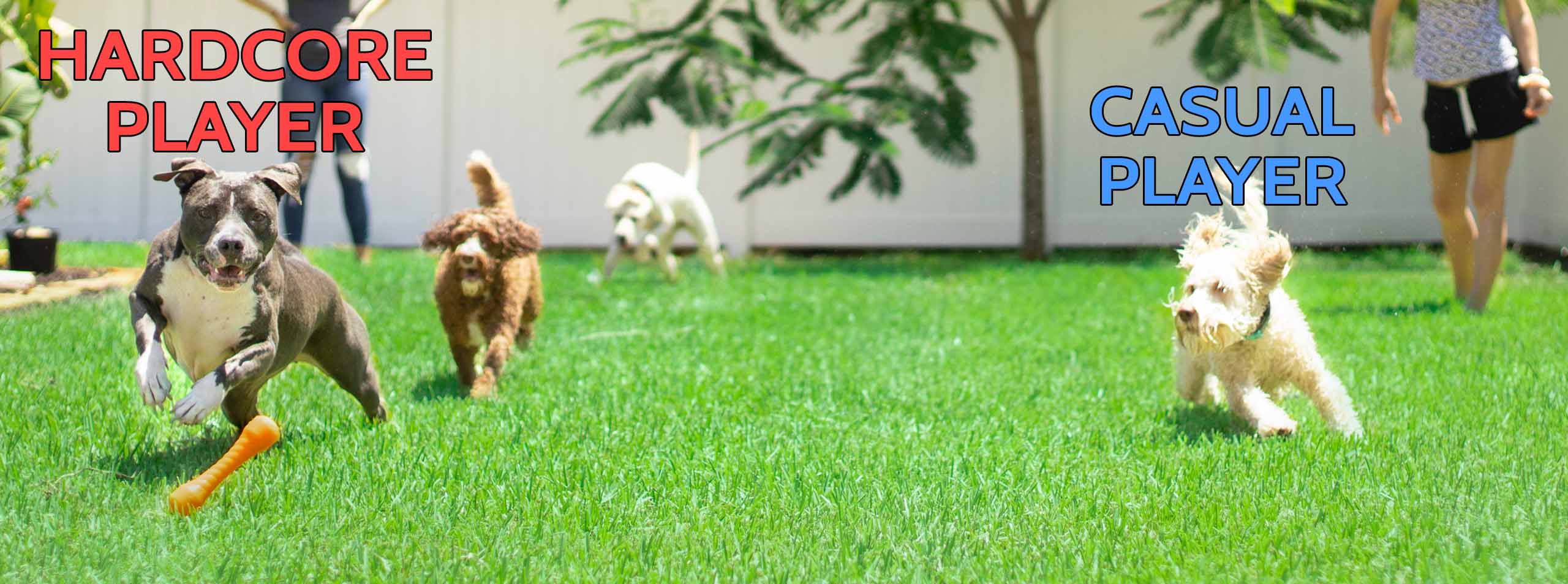
The Value of Difficult Content
Stay in Touch
Sign up for our newsletter to get exclusive Duple Dragon goodies and news in your inbox, and join our Discord server to chat with us and other players.
Casual vs. Hardcore: A Misguided Debate

There is an increasing split in the gaming public between “Casual” and “Hardcore” players, and arguments frequently break out between them about the game design direction of their favorite games. The argument is frequently presented as a dichotomy—two mutually exclusive directions—and goes as follows:
Casual players just want to have fun. Games with difficult content—especially content which requires coordination, organization, and out of game study, takes away from their fun. They see the hardcore players as toxic elitists who gatekeep difficult content by mandating how to play.
Hardcore players want challenge and prestige. Games that add too little content at the top of the difficulty curve quickly bore them. They see casual players as a whiny majority who advocate for dumbing down challenging content because they aren’t willing to put in the time to practice.
This is a false dichotomy. Accessibility and challenge can and should coexist, and in this post we’ll share some of our thoughts about what difficulty means to us, why it’s even important for casual players who never experience it, and how this affects our design vision for Duple Dragon.
Judging the Depth and Accessibility of a Game

Skill Ceiling and Skill Floor are two related terms used by game designers to describe the depth of a game versus the accessibility of a game. Depth, or the ceiling, measures how long a player can play the game and still find new challenges and experiences. Accessibility, referred to as the floor, measures how easy it is to understand the game at first glance and get enjoyment from it before a player is good at it.
Low Skill Ceiling and Low Skill Floor
This game is accessible and easy to understand, but is shallow and doesn’t have much to offer over the long term. A game like this could be a fun diversion, but will quickly become boring and trivial to win.
High Skill Ceiling and High Skill Floor
This game is rewarding and compelling for someone who puts in the time to understand and learn it, but its obtuse nature and high complexity will push most players away. Under its difficult exterior it might be a real gem, but few will stick with it long enough to find out.
Low Skill Ceiling and High Skill Floor
This game is just a bad game. It’s difficult to understand and appreciate, and offers little to no payoff for those who take the time to try.
High Skill Ceiling and Low Skill Floor, or the Gold Standard
This game is what most game designers strive for. It’s easy to wrap your head around when you first see it and fun right out of the gate, but as you play it more and more it continues to reveal new depths of experience and greater stages of mastery to work towards.
In order for a game to reach this gold standard, difficult content must exist. So must easy and accessible content. Most importantly, there must be a thorough and steady gameplay ladder to play through that allows a player to go from complete beginner to mastery.
Aspirational Content: Why Difficult Challenges Improve Casual Games

Aspirational content refers to experiences and challenges in a game that a player aspires to complete someday in the future. This is usually a challenge that’s too hard for them, either due to a lack of mechanical skill, or because their character isn’t powerful enough yet.
We believe that aspirational content is very important for a game to have longevity, even if the majority of players never experience it. It provides a long term goal, a mysterious and exciting destination to strive for.
The benefit of this type of content is rarely seen through data analytics, as the most difficult content in a game will always be the least played, sometimes dramatically so. This can lead game companies to de-emphasize it, or even stop creating it entirely. We think this is a grave error, and one which can start to eat away at players’ passion for a game as they watch its skill ceiling chipped away in an effort to ensure everything in the game can be completed by anyone.
Cameron Rich, a Senior Game Designer at Arenanet (creators of Guild Wars 2), thinks a lot of people misunderstand why challenging content is important:
“A lot of people will say it’s really important that you have content for your most hardcore fans because they’re the ones who care about your game the most. And yes, that is absolutely 100% true. It is really important.
It allows them to have something that over the years they will still want to do. And even though only the hardest of hardcore fans end up doing it, how do you think a hardcore fan is born? They start playing the game, they get really into, they get really good at it. […] They see someone run by on a mount or with an armor skin, and they’re like “I want to look like that guy! I want what that guy has! […] How do I do that?”
Having that aspirational content, regardless of how many people consume it, it’s still beneficial because it gives players goals.”
Challenge if You Want It

Our vision for Duple Dragon is a welcoming experience for new and casual players, but one which offers them a path to becoming an expert if they want to. To help new players, the core gameplay mechanics and goals are simple and easily learned. Players naturally increase their competence by being introduced to new concepts at a smooth but steadily increasing pace.
Our previously revealed stage generation system will create new stages each week that cater to the full skill spectrum. This includes easy stages for those still learning or who prefer a lower pressure experience, but it will also include stages that are unapologetically difficult. These hardest stages offer the greatest rewards, and players will be encouraged to explore and push their limits.
Our goal is to foster competition at the highest level of skill, while providing an accessible entry point for new players and a rewarding experience for them whether they want to push their limits or stay at a comfortable level.
To wrap things up, we’d like to share some personal feelings about difficulty in games from our team:
Souren
“Difficult content is extremely captivating for me. Some of my fondest gaming memories are getting together with friends and staying up all night trying to beat a game set to its most punishing difficulty. We’re trying to win obviously, but half the fun is in the ridiculous situations we get ourselves into trying to survive an experience that has completely outmatched us. And the feeling of competence that comes with honing your skill until you can do something you previously couldn’t is what keeps me engaged and having fun. I’m after the thrill of victory really meaning something.”
Ian
“In most games I avoid the hardest of hardcore content. Things like raids in massively multiplayer games or extreme difficulty modes in Diablo or Resident Evil are something I rarely seek out. Despite this, I find their existence exciting. I love hearing about or watching other skilled players facing these challenges, and they’re always there waiting for me to work up the nerve to give them a shot. It makes the game feel boundless, like it always has more to offer if I want it to. Games that don’t offer these kinds of challenges often feel shallow to me or even a let down. If nothing can defeat me, why should I stay engaged? If I can blast through a game on the first try I rarely find myself coming back to it later because there’s nothing left to learn from it. Challenge is the spice that makes the game worth playing.”
Caleb
“When I play a game, I love when I’m offered alternative paths (which typically lead to the same place), but along the way I’m given the opportunity to collect upgrades that I otherwise wouldn’t have received by only choosing the ‘easy’ way. For example, a game like Spyro can feel like a very casual game to the unsuspecting player… but while traversing its world the designers often left gems in ‘easy to see but difficult to reach places’. To me, this feels like an invitation to try the content in the game without the foreboding nature of explicitly choosing to play the ‘hard’ mode. All of my favorite games growing up followed this pattern of ‘optionally difficult’ content (Mega Man, Chrono Trigger, Zelda, Donkey Kong Country, Final Fantasy) and it’s definitely a major reason that I continue to replay those games today.”
Thanks for Reading
We hope you enjoyed this look into our game design philosophy. We can’t wait to get Duple Dragon into your hands early next year.
– Caleb, Ian, and Souren
Stay in Touch
Sign up for our newsletter to get exclusive Duple Dragon goodies and news in your inbox, and join our Discord server to chat with us and other players.

